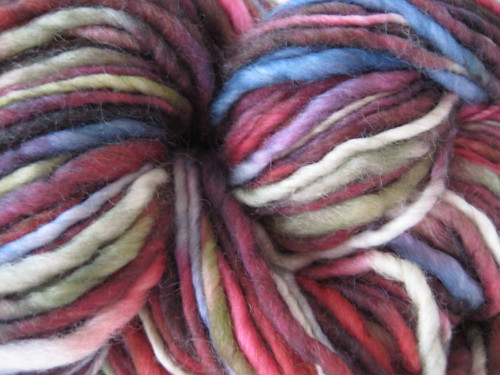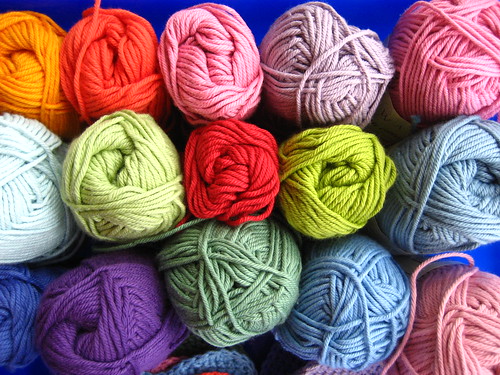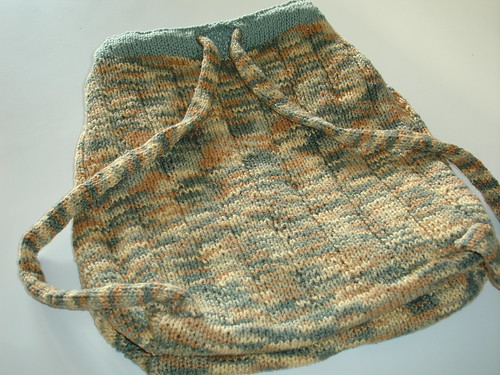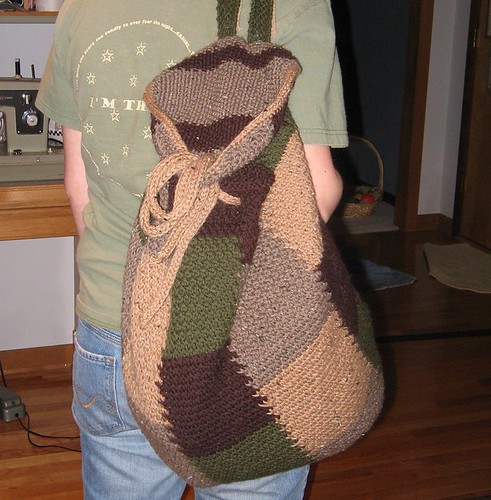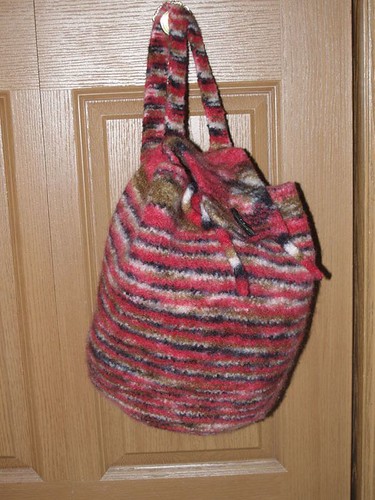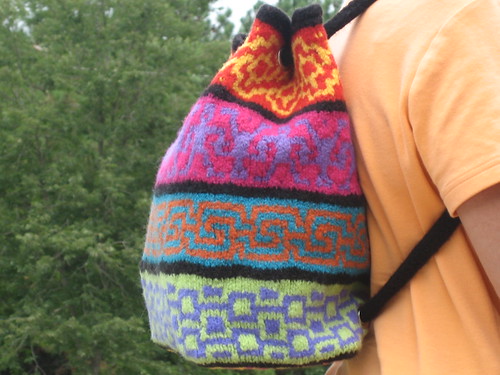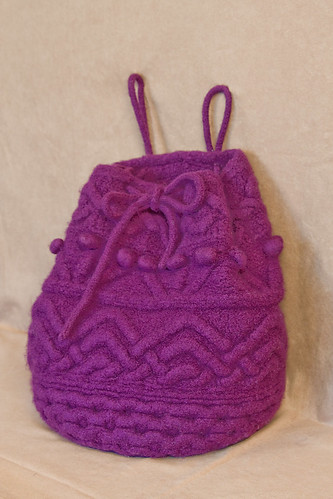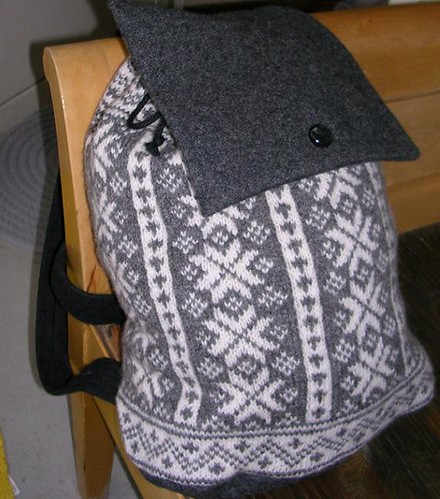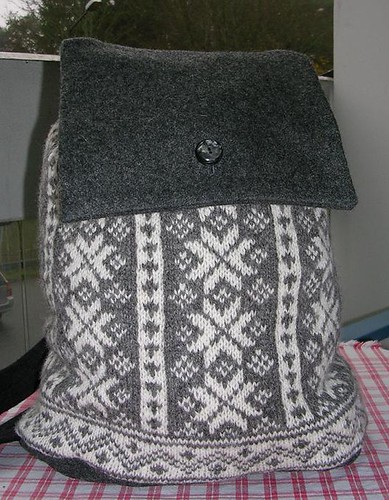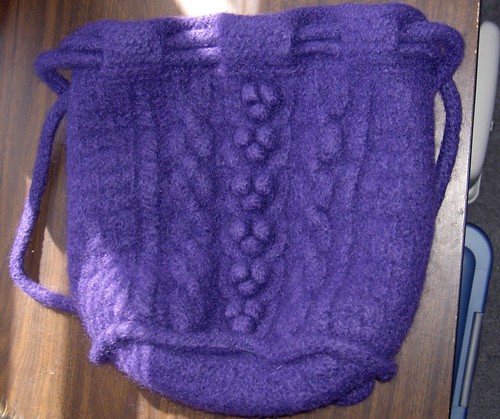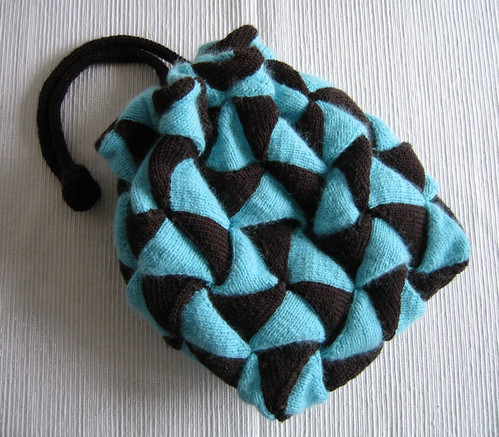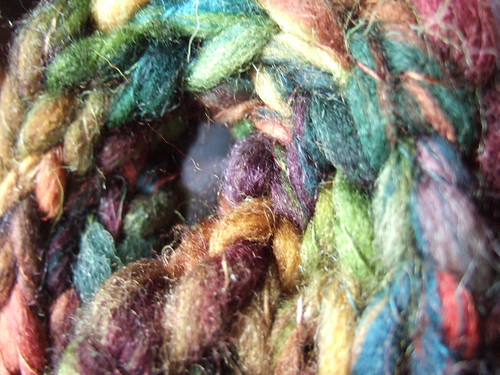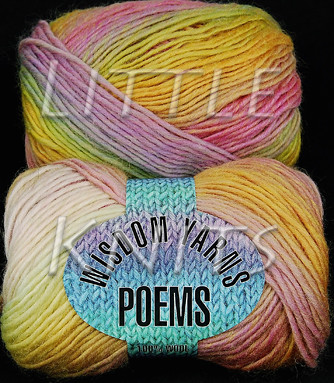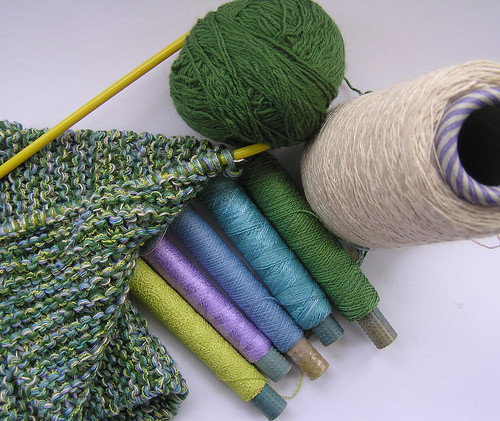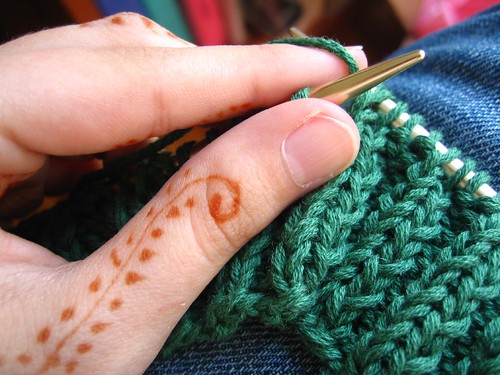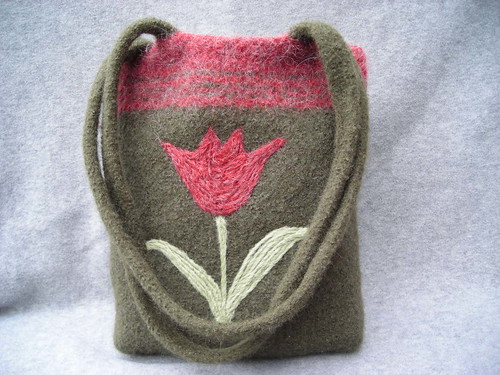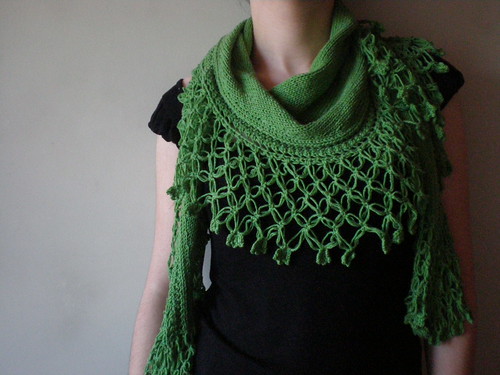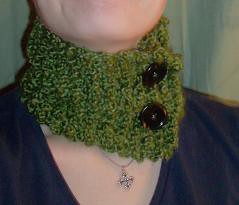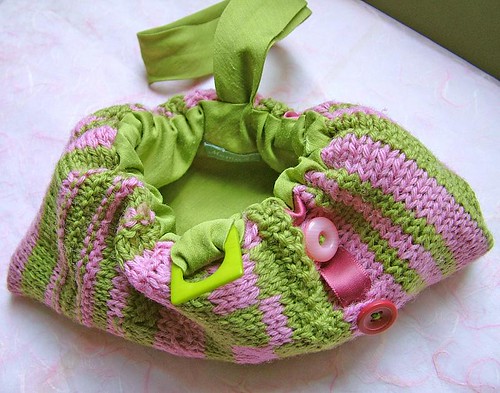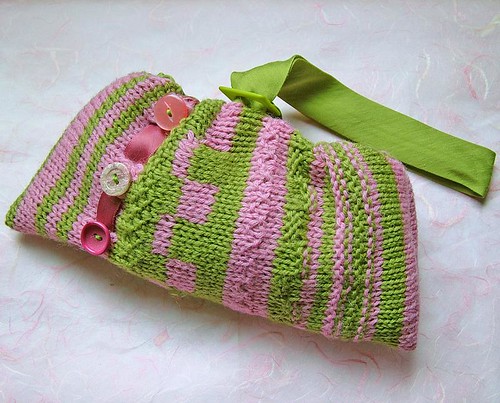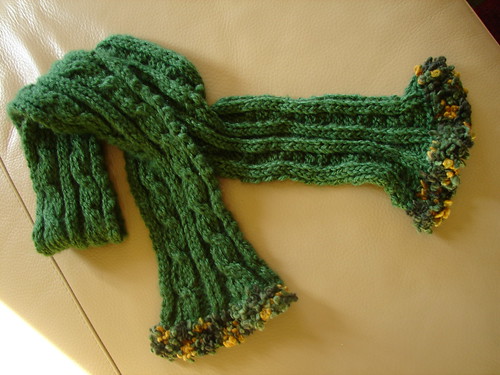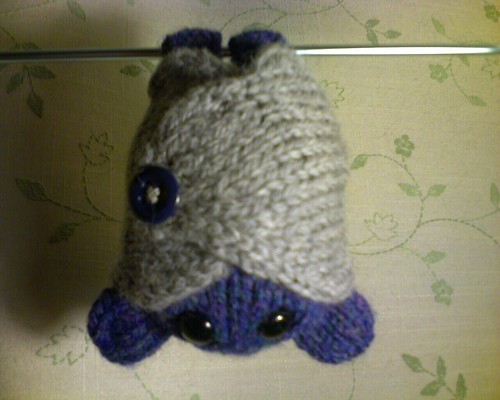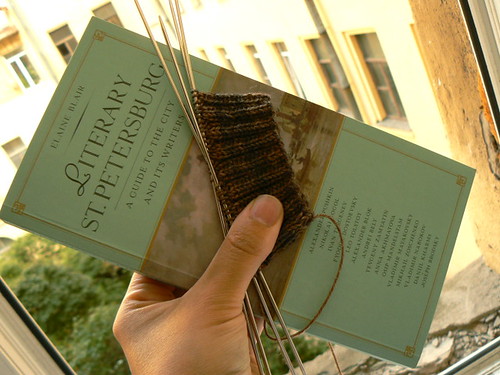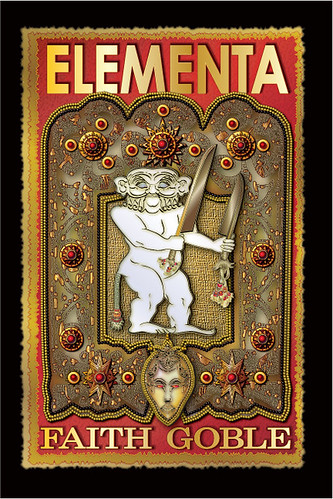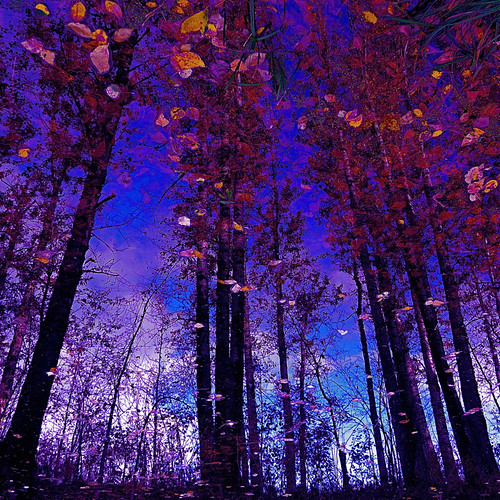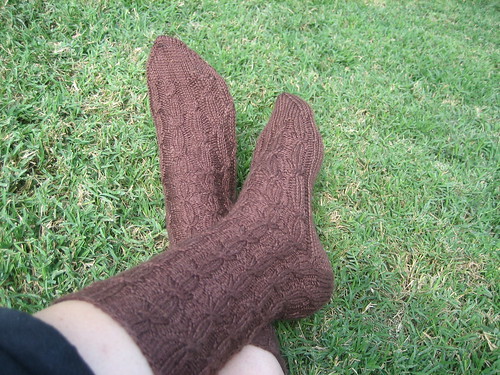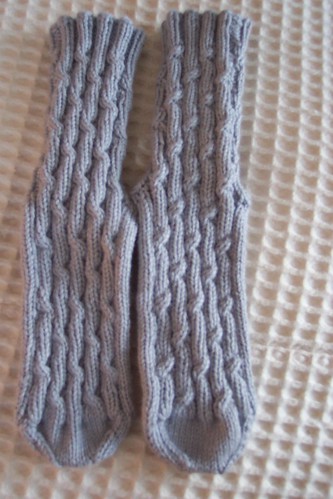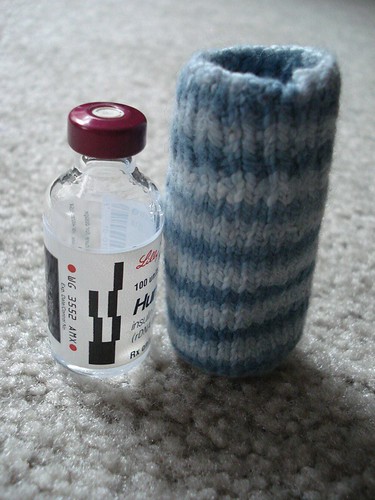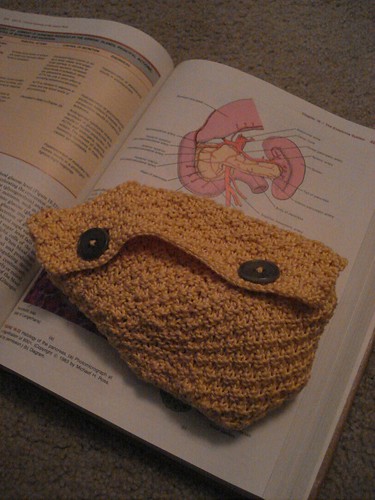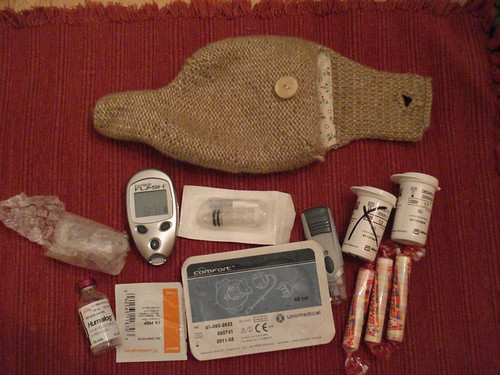This is fabulous!!! I love the look!
Here's what the knitter has to say:
"I designed this as my staff project for the spring 2007 Interweave Crochet. I fell in love with the ribbed ripples, having no idea they'd become so popular this season or that I'd continue rippling for months.
In the preview photo on the magazine's website you can't see the dangly rings, so here they are.
Yarn: Austermann Bambou Soft (65% wool, 35% bamboo; 110 yd [100 m]/1 3⁄4 oz [50 g]): #07 teal, 2 balls. Yarn distributed by Skacel.
Hooks: 6mm and 5mm"

Thursday, March 26, 2009
Float Away Scarf
Babette Blanket, First Squares
So pretty!
Photo note:
"Three years ago in Cambridge, MA, Greg saw Manos Del Uruguay yarn for the first time. He picked up a skein of colour 109 Woodland, and declared that I must make us an afghan out of it. He persisted despite my explanation that it would be wildly expensive. We bought all the 109 they had, along with some 54 Brick. Since then I've picked up some more of each, along with some green (55, I don't know the name), Wheat and Loden (can't remember the numbers).
We visited the afghan idea several times since then, but never came to a conclusion about a pattern. (I did nix his request for an afghan made of 4x4" squares of stockinette stitch.)
And then the grannying started. And then the Babettes. And then we went to Purl where Greg saw their Babette, and that, dear friends, was all she wrote.
This weekend I played with colours (we have 5; Babette calls for 19), and I started crocheting. The large square in the photo is the largest in the blanket, at 12 rounds. I don't like the colour scheme in it, but I'm sucking it up. Unlike for my random scrap grannies, I'm following this pattern to the letter, just for variety. (Ok, not to the letter. I'm starting with an adjustable ring, not the chains the pattern calls for.)The smaller square is 4 rounds. I'm using a 6mm hook and figure the blanket will be about 40% larger than the Koigu original. I have no idea if we'll have enough yarn. I'm starting out with 16 hanks; I'm hoping that'll do it. Stay tuned..."
Manos del Uruguay
Oh my, this is another of my favorite yarns. I have knitted and felted many many hats with it, and this yarn does beautifully. I've never used this color, but love it!
Anyway, all the hats I ever made with Manos sold very quickly. In addition to the fantastic colors, after felting the texture of the fabric is just a touch nubbly, and very classy looking. Finish the hat off with an un-felted 6 or 8 stitch cable hat band, and the hat looks quite stylish.
--TKC
Photo note:
"Multi #114
100% Wool"
Rowan dk cotton yarn
I love this shot - great colors for spring!
Photo note:
"My current stash of yarn - 14 colours of Rowan dk cotton.
Some of the brighter colours were used to make my flower scarf, and I have added some softer colours. Scrummy aren't they?!"
Saturday, March 21, 2009
Catherine purse in grey
Photo note:
"from "Knitting little luxuries" by Louisa Harding, batik fabric for lining, mother-of-pearl buttons as individual embellishment"
Spring Leaves Backpack
One to definitely check out! I like the design~
Photographer's notes:
"I designed this set for Mission Falls Accent booklet, published in February 2009, featuring 1824 Cotton yarn."
Felted Sling
Photo note:
"Here's the sling after felting and finishing. I've lived with it for so long that I couldn't really tell if it was cute or ugly. Random polling conducted throughout the day has been unanimous on the "cute" side with general consensus being that my 12 year-old niece will like it."
Bunny Buddy Bag - Stuffed!
Here's another look! Sweet!
"Buddy bags are child-sized knit drawstring back packs with whimsical pockets and finger puppet buddies. The pattern is an annypurls original and is available for instant download (includes all 4 variations).
See my blog at www.annypurls.blogspot.com for details on how you can get one too ;0) "
Bunny in a basket
Okay, this is way to cute to pass up, and anyway, Easter is coming...
Photo note:
"Buddy bags are child-sized knit drawstring back packs with whimsical pockets and finger puppet buddies. The pattern is an annypurls original and is available for instant download (includes all 4 variations)."
Vogue Knitting on the Go: Bags and Backpacks
Photo note:
Brown cableknit hobo purse from Vogue Knitting on the Go.
"Gravenstein" Handknit Felted Backpack Handbag
Wow - I'm impressed! Looks better than my Gravensteins, by far!
The photographer says:
"My entry in an etsyFAST challenge where the theme was "apples." Made of freeform knit bright green Merino wool in a 4x2 rib pattern. Wet felted. Flaps cut into leaf shapes & embellished with embroidered veins. "Blushed" with a wash of rust brown fabric paint. Drawstring sild I-cord closure. Single backpack strap. Small freeform crochet apple worm graces the front. Unlined. Original design. For sale."
Terra Cable Bag - side
Mmm, this on turned out well, too. Photographer's notes:
"This felted backpack is worked one panel at a time. The pattern is available via Knitting Arts in Saratoga, California"
Felted Backpack
This has a nice quality to it. Here are the photographer's notes:
"Pattern is Fabulous Felted Backpack from Bags, a knitter's dozen
Yarn is Lamb's Pride Bulky, M-56
This is the first thing I knitted and felted"
Nice work!
Thursday, March 19, 2009
Spinnin' series: Knapsack 3
Cool!
Photo note:
"Pattern available soon. My own design, hand knit. Knit pattern."
Fickle Fingers
I love the edging on this one.
Photo note:
"Here's a Fickle Fingers scarf made from some worsted weight Lorna's Laces yarn that I had in my stash.
This pattern is a freebie at the Interweave Knits site. It's a great pattern for handspun yarn and is the perfect knitting for watching The Wire."
Tuesday, March 17, 2009
Poetry, Knitting, and Fibs
1, 1, 2, 3, 5, 8, Fun...
What's a Fib? Math plus poetry.
BY DEBORAH HAAR CLARK
One
Small,
Precise,
Poetic,
Spiraling mixture:
Math plus poetry yields the Fib.
Gregory K. Pincus wasn’t expecting to start a movement when he posted this Fib—his very first—to his blog last year. The Los Angeles writer, volunteer librarian, and dad was simply commemorating the opening of National Poetry Month by sharing the six-line, 20-syllable poem.
“I put it on the Web as a writing exercise,” says Pincus, who dubbed the poems Fibs for their basis in the Fibonacci sequence. The number of syllables in each line of the poem is the sum of the previous two lines: 1, 1, 2, 3, 5, 8. “The constrained form makes you very conscious of word choice.”
Pincus came up with Fibs while pondering a haiku writing exercise. A confessed math geek, he sought a form that offered added precision and was intrigued by Fibonacci numbers. In nature, the sequence is evident in the spirals of nautilus shells, waves, pinecones, and sunflower seeds, to name a few. The numbers have also popped up in all kinds of creative works since even before the birth of the mathematician for which the progression was named.
Pincus played with the number sequence for his own amusement, creating one of his favorite Fibs:
Fib Time
Tell
Fibs.
What time?
Every day
Two seconds before
Clocks hit 11:24.
“I don’t know that there was any other attraction other than I thought that it was a neat sequence,” says Pincus. “It was different. A seemingly odd combination of mathematical sequence and poetry that really works.”
It is not difficult, he says, to come up with a 20-syllable line that fits the Fibonacci structure. The hard part is to come up with a 20-syllable line that reads well.
To be sure, Fibonacci poetry is not new. It’s been around in one form or another for centuries, with works applying the numerical sequence to syllables, words, or letters. What makes Fibs remarkable is how quickly they spread.
Pincus posted the first Fib on his children’s literature blog, gottabook.blogspot.com, on April 1, 2006. Intrigued readers began submitting their own Fib creations. Six days later, Slashdot.com, a technology-focused site with the tagline “News for Nerds, Stuff that Matters,” linked to Pincus’ Fibs post, and interest in the poetic form ratcheted up considerably.
“That was the day I had 32,000 visitors on my blog,” says Pincus.
Slashdot readers jumped on the new form, turning out pages of their own poetry and producing far more Fibs fans, including poet Alan Reynolds, who posted his take on Fibs in Fib format.
This
form
forces
fine feelings
into abstruse lines
each longer longing to affix
a meaning to creations made live by febrile minds
and for this new spring trick I thank both you and SlashDot. Well done.
Though if continued cumbersome.
“The success of this story was entirely because the poem was based on the Fibonacci sequence,” says Rob Malda, Slashdot founder. “Geeks love interesting number sequences, and that one is way up there. Generally speaking literature by itself isn't our typical subject matter, but interesting use of math definitely is.”
Within days, Fibs could be found on sites around the Internet.
Then the New York Times called. A mere two weeks after Fibs first appeared, the nation’s newspaper of record published an article detailing the poetry phenomenon.
Suddenly, Fibs were everywhere. Sites dedicated to actuaries, gamers, poets, mathematicians, teachers, musicians, librarians, and Italian stockbrokers were reporting on Fibs—with many readers posting their own.
“The response was pretty remarkable and across so many communities,” says Pincus. “It attracted people who used Fibonacci numbers in their work and those who liked the puzzle aspect or the poetry aspect.”
Blogger Marilyn Roberts announced a contest for knitting-related Fibs on her site, The Knitting Curmudgeon (www.knittingcurmudgeon.com), with the following Fib:
Fib to a Knit Dweeb
I
spend
my days
wondering
if Lion Brand Fun Fur
will make a nice pair of undies.
“Most accomplished knitters know the value of mathematics as applied to knitting—certainly geometry and algebra are needed to calculate shaping if you design your own garments,” she says. “My readers are pretty erudite, so I knew they would find it a challenge not only to create the Fibs but to use knitting as the subject. And it was great fun for all of us.”
Fibs also went international, appearing in French, Japanese, Korean, Portuguese, Spanish, Dutch, Greek, and other languages.
The attention only added more fuel to the Fib fire.
The British newspaper The Independent carried an article that stated, “Fibbing, if we can call it that, may be just the thing for a lazy bank holiday weekend. Alternatively, it might just drive you round the bend. And there is the danger, of course, that once you start, devising Fibs will become as addictive as crossword-filling or Sudoku-solving.”
So what is the appeal of Fibs?
These short, straightforward poems are that rare thing capable of crafting a bridge between the often disparate souls of art and science. It helps that the form is exceptionally easy for anyone to understand. Pincus reports that he’s received several e-mail messages from teachers reporting that Fibs are a great way to combine math and English, and to explain the Fibonacci sequence to the non-mathematically inclined.
The simplicity of the form is part of its appeal, says Tony Barnstone, poet and professor of English language and literature at Southern California’s Whittier College (home of the Whittier College Poets, named by USA Today as the least threatening college mascot in America, topping even the Mary Baldwin College Squirrels and the New York University Violets).
“In my experience, people are extremely hungry for poetry, but they don't have access to it; they can’t find the door,” says Barnstone. “The hothouse poetries of the academy are not written for them, and so they turn to forms that are more inviting, to spoken word, to rap, to haiku and to the Fib. Once inside the house of poetry, they can feast.”
The phenomenon of ordinary folks, as opposed to professional poets, experimenting with poetry is widespread and timeless. As examples, Barnstone points to the oral poetry tradition in modern Greece, exemplified by the Cretan mantinades (morning songs), an oral poetry form used in music and courtship, and the popularity of tanka and hokku (haiku) in Japan.
And Fibs are not the first forms of poetry to quickly win acclaim, although the Internet surely accelerated the process.
“Perhaps one could compare the spread of the Fib to the spread of the sonnet in England after its introduction to English by Henry Howard, Earl of Surrey, and by Thomas Wyatt, or to the sonnet sequence fad that Sir Philip Sidney began, or to the spread of renga under the influence of Basho,” says Barnstone. “In cultures such as China and Japan, poetry was central to the life of the people, and so a widespread popularity of particular verse forms was common in many periods.”
Of course, the swift rush of Internet celebrity is accompanied by an equally speedy fall into fustiness. Although they’re not even two years old, Fibs are ancient news online. But they continue popping up on sites here and there.
Pincus is one of those who continue writing them, and in fact is working on a novel that includes Fibs. He hopes that the little poems continue to proliferate.
“Fibs are good clean fun, and playing with form, any form, that inspires people to write is good,” says Pincus.
Dunk!
by Gregory Pincus
Slam!
Dunk!
Soaring . . .
I'm scoring.
Crowd keeps on roaring.
In my dreams I'm unstoppable.
Monday, March 16, 2009
Knitting in the News
Knitting in the news
Posted by mmooney January 28, 2009 15:55PM
Picture it: You're rushing up a flight of stairs to get to your knitting club meeting. You're carrying (naturally) knitting needles. You trip. You feel a stabbing pain. You realize you've stabbed yourself. In the heart. With a knitting needle. Nope, it's not a knitting urban legend -- it's the story of Ellin Kor, who did just that, and survived. Read all about it here.
Me, I'm impressed as hell with this lady. As a congenital klutz who spent her childhood being picked last at gym (with reason, I might add), I can totally see myself getting impaled on my own knitting equipment one day. I wouldn't have to be running up stairs, though -- I suspect I could manage to stab myself while sitting the couch. (Anyone who doubts this has never seen me play softball. Or attempt to follow an aerobics routine.) So I'd definitely be able to stab myself. But there's no way in hell I'd have the presence of mind to know what to do afterward.It's possible I'd go to pieces and scream. It's possible I'd run around wildly, hit a wall and knock myself out. But it's most likely I'd be all, "*&^%!! I better not have messed up that needle!" And I'd yank the thing out to check, bleed to death (thus ruining my yarn) and go down in knitting history as the first woman to value her Addis over her life. (Not to brag, but I've got a double set of 16" Addi circs from size 0 to 10.5. AND a set of 32" Addi circs from size 1 to 13. So I'm guessing most knitters would value my Addis more than my life, and they'd be right.)
So needless to say, I was very impressed with Ellin, but less so with the reporting job on this story. It's always painfully obvious when nonknitters try to do these kinds of stories, isn't it?
For instance: Was the needle a straight, a DP or a circ? Birch? Ebony? Walnut? What was the needle being used for? What size was it? (I gotta figure if you're gonna stab yourself, a lace needle's better than, say, a 10.5, but what do I know?) What kind of knitting club was it? Were they knitting for charity, was it a S&B, a combined knit/spin meeting? What was Ellin making when all this went down? Was she able to knit after the surgery?
How long has she been knitting? Is she a sock knitter? A lace knitter? Did the members of her knitting club make her presents (socks!) while she recovered? (I'd like to think so.) Was the friend upset that her knitting needle was broken? (I'd like to think not, but hey, stranger things have happened, right?) What's her favorite fiber? I'll grudgingly admit that nonknitters wouldn't care about these things -- and wouldn't get the lingo, frankly; let's face it, tell someone you took an Addi 00 32 to the heart, and they'd assume you'd been shot by a German spy -- but really, inquiring knitters want to know.
But since we're unlikely to ever know the whole knitterly story, let's all knit on, content in the knowledge that we really are wielding potentially deadly weapons. And let's be really careful on the stairs. Happy (careful) knitting, Ellin.
For more in the knitting news, check out http://blog.oregonlive.com/knitting/
Saturday, March 14, 2009
Knitting as Performance Art?

This is what you get when you cross knitting with perfomance art..., originally uploaded by A is for Angie.
Photo note:
"This is what you get when you cross knitting with perfomance art..."
Knitting Art - a book by Karen Searle


Flair and Flash, Not Frumpiness
Long viewed as the domain of grandmothers, needlework has undergone an image makeover in the last decade. Snowboarders, the old torchbearers of alt.culture, have embraced crocheting, making beanies to wear on the slopes; coffeehouses and subways are filled with fashion-conscious types busily knitting or doing needlepoint. And contemporary artists like Andrea Zittel, Lisa Anne Auerbach, Orly Genger and Jim Drain and the Forcefield collective have given crafts a coolly conceptual edge.
Time then for an exhibition celebrating the unfrumpiness of craft, and, sigh, what better institution than one that recently went through its own makeover, changing its name from the American Craft Museum to the sexier Museum of Arts & Design?
The sorry news is that, despite its title, “Radical Lace & Subversive Knitting,” with around 40 works by 27 artists, is not a benchmark for introducing such crafts’ coolness or radicalism to a vast art audience. Rather than exploring transgressive takes on knitting, the exhibition, organized by David Revere McFadden, the museum’s chief curator, devotes most of its space to art that mimics the look or logic of knitting and lace and translates it into different materials.
In an essay in the show’s catalog, Mr. McFadden does invoke interactive performances held in abandoned warehouses and the London Underground and people who knit sweaters for “oil-spill-damaged penguins to wear in Antarctica” — the kind of activities you might associate with radical or subversive practice.
But in choosing the work for the show, he cites somewhat dated textile and crafts-based artists like Sophie Taeuber, Sonia Delaunay, Judy Chicago and Magdalena Abakanowicz as his models.
Much of the art on view is in the large-scale, virtuosic craft vein. Henk Wolvers’s flat sculptures created with porcelain slip, a form of liquid clay, borrow the tracery if not the actual patterns of lace. Piper Shepard’s “Lace Meander” is a series of hanging muslin scrolls into which the artist cut lace patterns with an X-Acto knife. Bennett Battaile’s delicate sculpture of thin glass rods and Barbara Zucker’s rubber sculptures both invoke lace-tracery in heavier materials.
Some of the artists address “issues of politics, gender and ethics,” as a wall text puts it, in a general way. Janet Echelman’s giant, hand-knotted nylon net hanging from the ceiling in the museum’s entryway recreates the look of a nuclear mushroom cloud. Freddie Robins’s sinister-looking gray-knit bodysuit, with the words “Craft Kills” emblazoned across the chest, alludes to the airline ban on knitting needles in the post-9/11 era.
The works most in keeping with the show’s politically charged title are more interactive and collective, or more related to performance. For example, Cat Mazza’s collectively crocheted “Nike Blanket Petition,” a campaign against sweatshop practices represented here in a series of photographs, will be sent to Nike’s corporate headquarters.
A video of Dave Cole’s “Knitting Machine” project shows two John Deere excavators wielding telephone poles tapered to look like knitting needles — and missiles — to knit a giant American flag in the courtyard of the Massachusetts Museum of Contemporary Art in North Adams, Mass.
Sabrina Gschwandtner, an artist and founder of KnitKnit magazine, has set up a “Wartime Knitting Circle” surrounded by panels made of industrially knitted photos of Vietnam War protesters knitting, British women knitting woolen covers for World War II hand grenades, soldiers knitting during World War I.
She invites people to join her in knitting “blankets for recovery” for people in Afghanistan and troops convalescing in military hospitals, among other projects. (On the exhibition’s opening day, Ms. Gschwandtner was chatting and knitting with Phyllis Rodriguez, whose son died in the north tower of the World Trade Center on 9/11 and who has since befriended Aïcha el-Wafi, mother of Zacarias Moussaoui, a French citizen of Moroccan descent serving a life sentence after his conspiracy conviction in the 9/11 attacks.
Needlework indeed has a radical past. William Morris, a mainstay of the Royal School of Needlework and the Arts and Crafts movement in England, protested late-19th-century industrial production. Feminist art in the 1970s drew heavily on so-called women’s work, and Rosemarie Trockel’s “knitting pictures” of the 1980s cleverly drew on political themes.
So many more artists might have been included whose work explores the social aspects of knitting and lace or who more radically recast these forms: Simon Perotin, of the punk-doily creations; the artisans in the Church of Craft; Ms. Zittel; Ms. Auerbach;, Mr. Drain; and so on.
Given the show’s title, some visitors will arrive wanting to know how needlework, which runs counter to our technology- and information-saturated age, has become such a cultural juggernaut, and how it might serve to break down the barriers between artist and amateur, art and craft. A few works here may well satisfy that desire. Most will not.
“Radical Lace & Subversive Knitting” runs through June 17 at the Museum of Arts & Design, 40 West 53rd Street, Manhattan. Hours: Daily, 10 a.m. to 6 p.m. (until 8 p.m. on Thursdays); closed on holidays. Admission: $9; $7 for students and 65+; and pay-what-you-wish on Thursdays after 6 p.m. Information: (212) 956-3535;madmuseum.org.
A series of public programs related to the exhibition is planned, including lectures, panel discussions, performance pieces and workshops in knitting, lace-making, crocheting, fabric-making, fabric-printing and digital design. Some events are free with museum admission; others require an additional fee that includes admission.
Beginning tomorrow and running every Sunday from 2 to 4 p.m. through June 3 will be “Well Crafted Weekends: Inter-Generational Workshops,” for those 6 and older; $7 per person or per family (up to four people). A detailed schedule is on the Web site.
Universal Yarns Poems
Ready for Spring!!!
"A self-striping 100% wool, that knits and felts."
Keywords:
Poems yarn photo, poems yarn, Wisdom yarn, little knits
Asteraceae ... Knitted Neckwarmer / Scarflette - Chartreuse Green

Asteraceae ... Knitted Neckwarmer / Scarflette - Chartreuse Green, originally uploaded by irregular expressions.
Wow--this is great! Amazing!!! And it looks great with the simple black top,
Keywords:
Knitted neck warmer, knitted scarflette
Plain knit green blend 2
I love this type of knitting, holding two or more yarns together to create something totally new.
Photo note:
"Its that time of year that I have time in the evenings to try to knit my way through my yarn stash. I have literally hundreds of hand dyed spools of yarn which are fun to combine into colour groups. Plain knit of course! (thats all I can manage!)"
Keywords:
spooled yarn, knitting two or more yarns together, blending yarn, knitting with several yarns
green knitting markers
How pretty~ I can just imagine these against a rich purple or rose colored yarn...
Photo note:
"A nice fresh green color for these."
Glass button knitting stitch markers
project stashbust - my green problem
I think I have a green problem, too! I love the color. Maybe it's due to being a redhead?
Here is the photographer's note:
"All my stash suitable for Project Spectrum's April/May directive (green/yellow/pink).
Anyone want to guesswhat my favorite color is?"
Yarn stash photo, green knitting yarn, wool yarn, cotton yarn
green knitting and henna
Beautiful!
Photographer's note:
"henna from celebrating Persian New Year"
Keywords:
Green yarn, green knitting yarn, henna tattoo
Olive green knitted felted tulip tote with needle-felt
Nice! I have a soft spot for felted bags and hats, as I used to have a knitting business in which I made many of them. This felted bag is great~
Here is the note that goes with the photo:
"My newest creation! I had fun designing this tote and needle-felting the tulip on it, since tulip season is huge in our region of the Skagit Valley!
For more info, check out my profile!"
Presence - Green Knitted/Crocheted shawl/scarf
Wow--this is very nice! I love it! The fringe is fabulous!
Keywords:
knitted green scarf, knitted green shawl, knitted and crocheted shawl (photo), knitted and crocheted scarf, green shawl
Leaf Green Soft Knit Scarflette Neckwarmer
This is quite pretty. I love the yarn.
Here is the photo note:
"The Leaf Green Soft Knit Scarflette Neckwarmer is knit with soft yarn. The scarflette measures 18" long and 5.5" wide and has a 2 button close. The scarflette is machine washable and dryer safe."
Green knitted cable stitch Scarf
This knitter says:
"I finished my scarf. I knitted this with Lion Brand Jiffy yarn & a fun bumpy green & yellow poly blend I found at the LYS (local yarn shop) here in Monterrey. Now if we will get some cool weather again...."
Keywords:
Green cable knit scarf, green knitted cable stitch scarf, Lion Brand Jiffy yarn scarf
Tuesday, March 10, 2009
A Knitting Image

Monday, March 9, 2009
Shhhhh, Boo is sleeping
Okay, this is too cute! This is what I found when I searched for Twitter Knitting.
Key words:
Knitted bat, knitted animals, knitted creatures, knitted critters
Sunday, March 8, 2009
travel knitting
Couldn't resist - this is a great shot, and a wonderful combination: knitting and the literary arts.
Photo note:
"Four days in St.Petersburg - knitted only 15 rows..."
Friday, March 6, 2009
Elementa (illustration and poem)
As it's been awhile since I've posted a poem, here's one that could spark a new knitting creation. . .
Photo note:
Elementa (illustration and poem)
This cover illustration was created in Adobe Illustrator. The title of the book is taken from a poem I wrote about the earth, which focuses on the elementals (fire, earth, water, and air). The frightening guy with the big bronze knives represents one of the elementals of Paracelsus, a gnome I think--certainly not an undine!
"Elementa
I am the earth,
And from my mineral heart
Spring arteries of iron.
Beneath my loamy flesh
There rests a skeleton of stone,
Fed by my fiery blood.
I am a stone—
Heavy as iron and pushing
Into the earth.
I am immovable
While overhead the stars wheel
Toward their doom.
I am iron—
Unyielding, harsh, and cold.
I am born of the stone
To be reborn into innumerable forms
Of utility.
I am a river
And as I quicken towards the sea,
I run under the rusty bridge,
Between banks covered
With rank green growths
Spangled with glittery bits
Of cellophane.
I am the sea—
Quicksilvered union
Of a trillion, trillion drops.
I am broken shining
Into liquid shards,
My myriad faces lambent
With gelid fires.
I am the mist
And I ride above the waters.
I have married air
And left her pregnant
With rain.
I am the wind,
Nursemaid for the air,
And I traverse the earth
With humid clouds transported
In my arms.
I am a fire drunk on the wind—
Ardent beneath the burning stars,
I blaze golden, blue, and orange—
Speaking in tongues,
Dancing alone.
taken from Elementa (Loosey Goosey Press, 2008) by Faith Goble
You can read Luan Gaines' review of Elementa at www.curledup.com/elementa.htm
and an interview at www.curledup.com/intfgoble.htm."
Autumn Poem!/Poème d’automne!
Gorgeous! A wonderful inspiration for choosing color for your next project~
Sugar-Free Cocoa Socks
Photo notes:
"Pattern: Karen's Sugar-Free Diabetes Walk Socks
Pattern Source: knittinmom.blogspot.com/2006/09/do-i-take-advantage.html
Yarn: KnitPicks Gloss Cocoa Colorway
Needles: KnitPicks Circular size2 US
Modifications: Two extra pattern repeats on the legs
Notes: Next time I use this pattern (and I definitely will), I'm going to attempt it from the toe-up. It's just starting to get frustrating for me to have to "guess" how much yarn I'll need for the entire sock. With toe-up socks, there's none of this "I wonder if I'll have enough yarn to finish if I do one more pattern repeat".
Completed: October 2006"
Karen's Sugar-Free Socks
Photo notes:
"Knit in Debbie Bliss Cashmerino Aran on size 1 (2.5mm) needles. Pattern by Chrissy Gardiner of Gardiner Yarn Works. $2 from the sale of this pattern goes to support diabetes research."
Keywords:
sugar free walk socks, diabetes socks,
insulin sock with insulin
Another good idea - great for keep those little bottles safe while on the road.
"Made to protect my insulin while it travels with me, from some leftover sock yarn."
Keyword:
insulin sock
Pierre the Pancreas
Here is another look at the knitted pancreas pouch for holding diabetic supplies.
Photo note:
"With a drawing of the relevant part of the anatomy for reference."
With thanks to Kirinqueen
stuffed pancreas
This is great! A little knitted pancreas to hold all the diabetic supplies. (Much nicer than the one my son uses right now!)
knitted pancreas, with supplies
Today I've spent time online looking up possible places to order diabetic supplies for my son, who is fairly newly diagnosed (5 month ago). I did find an article on making socks for diabetics, but wanted to see what else I might find that involved knitting. I found some very creative things, which I'll share.
Here is the note to go along with this photo. Oh how familiar all the items are to us now!
"These are the diabetic supplies that I always carry with me. Missing: spare AAA battery for my pump, and a syringe in case the pump fails."



